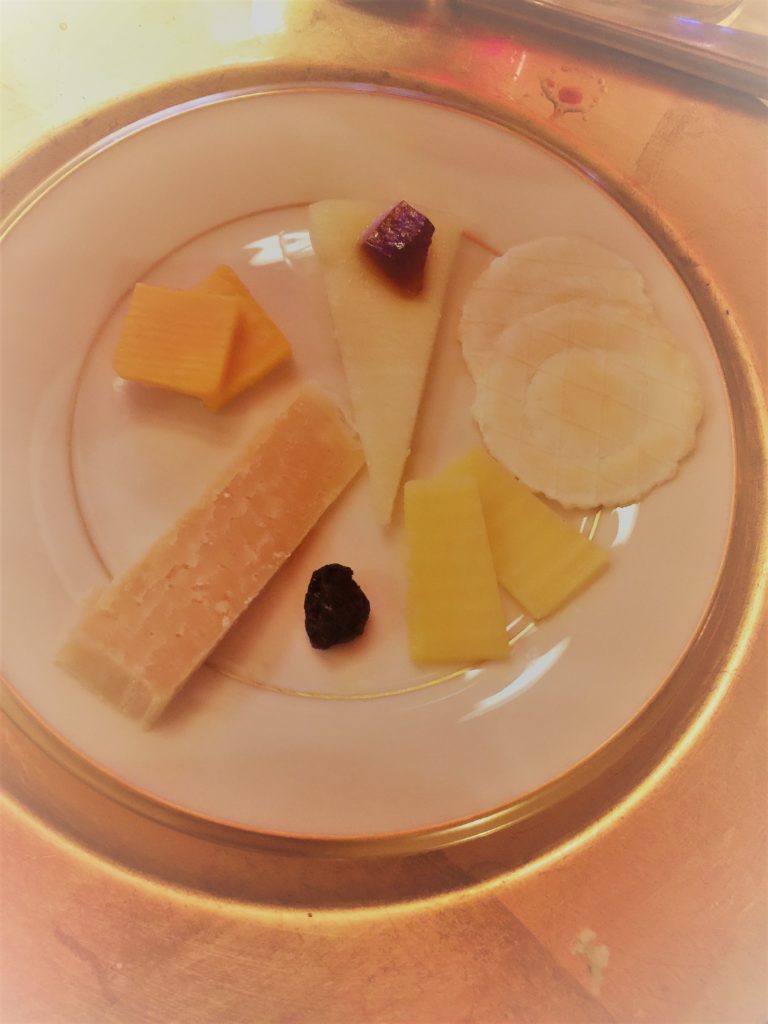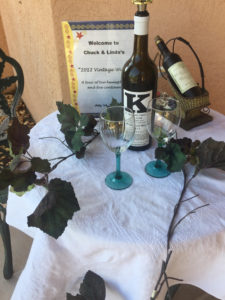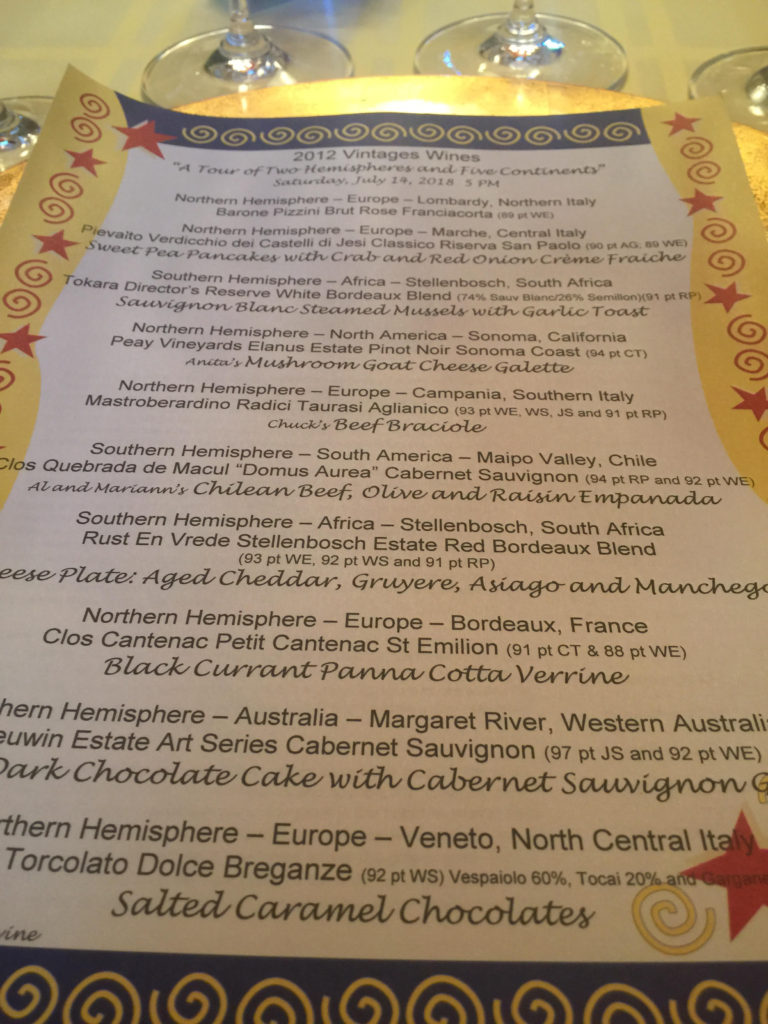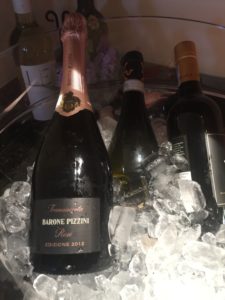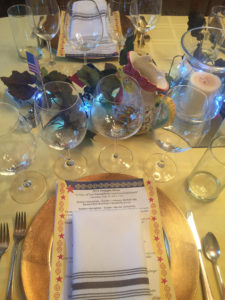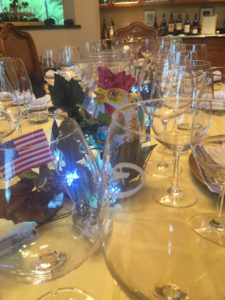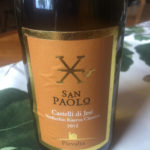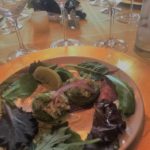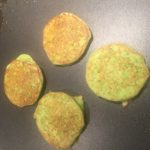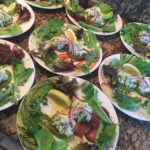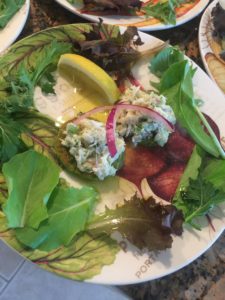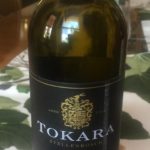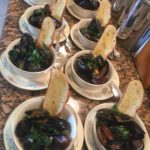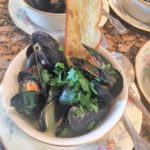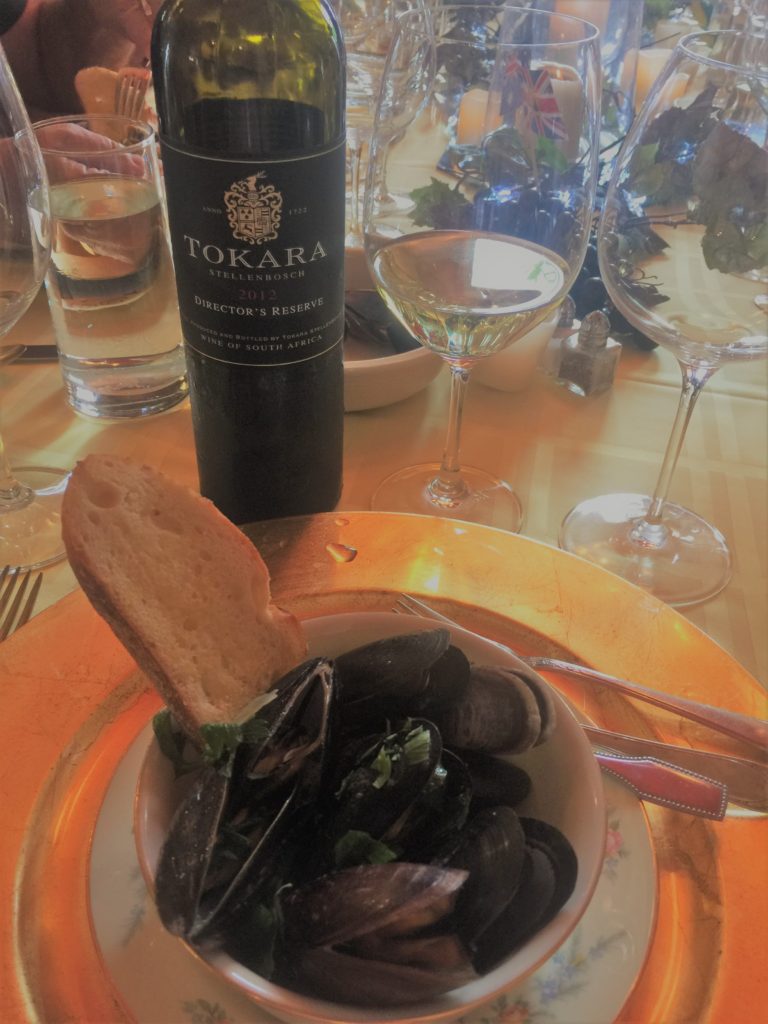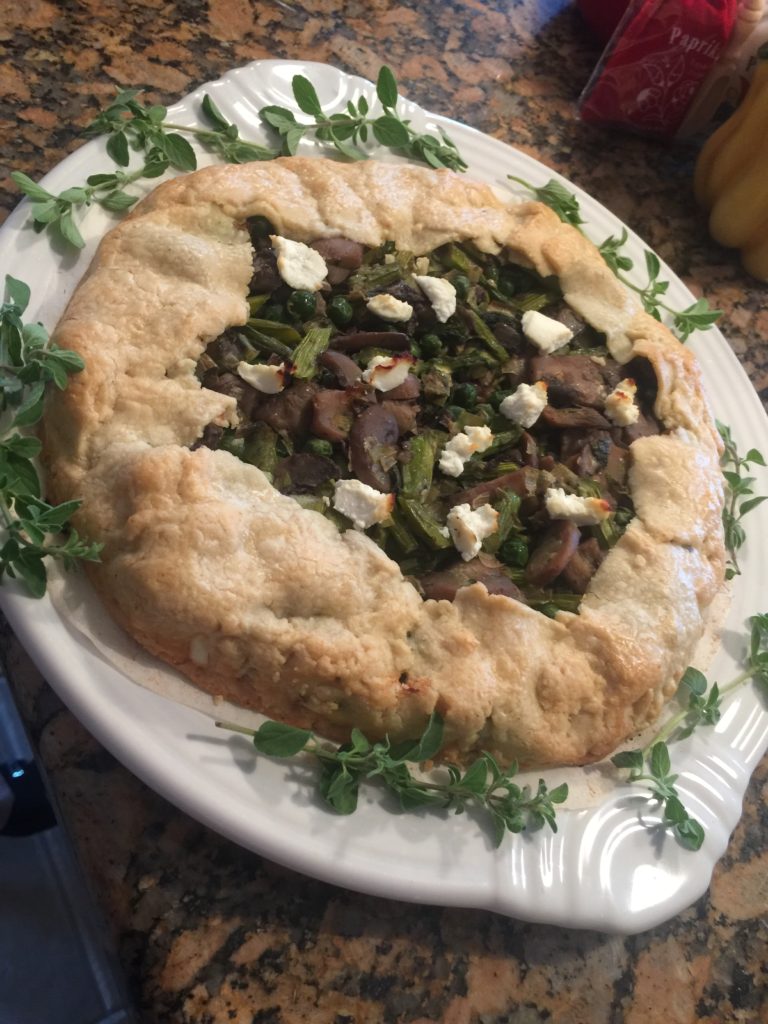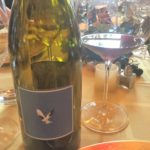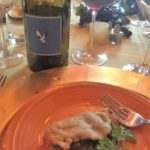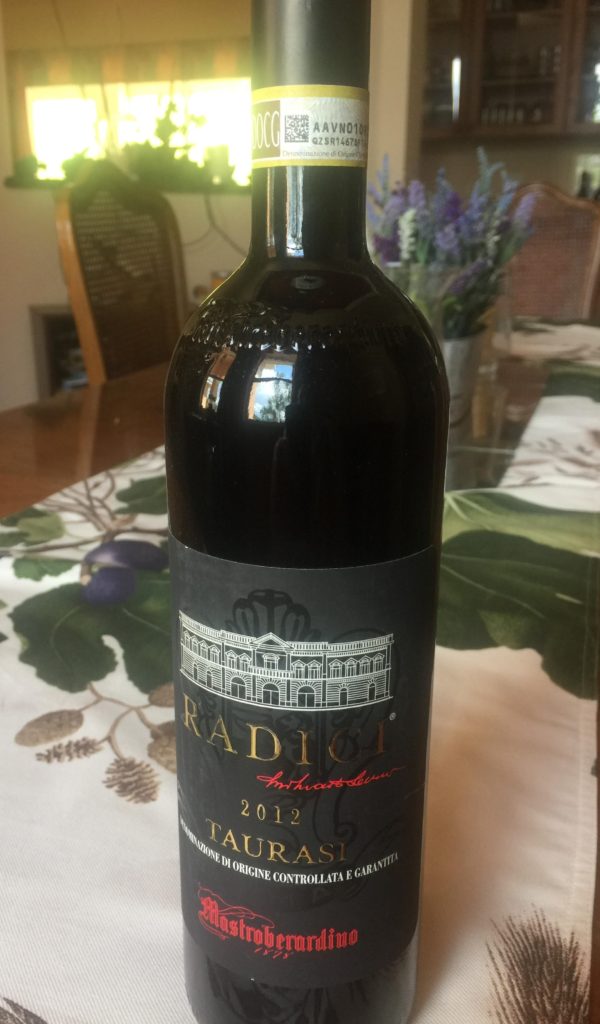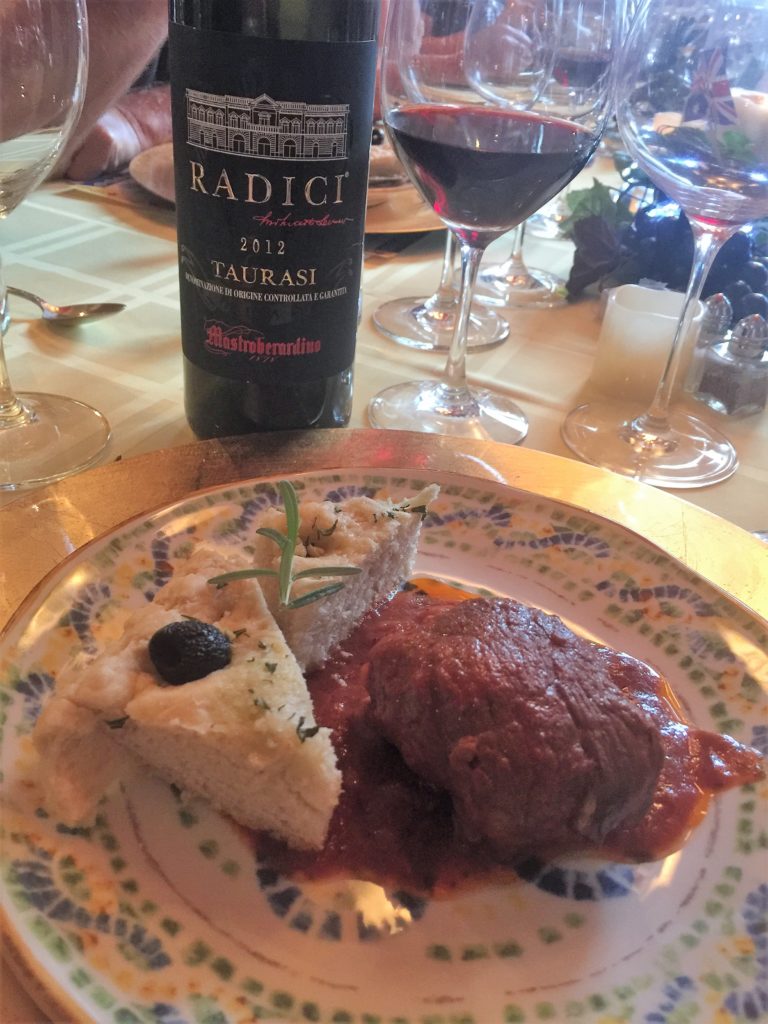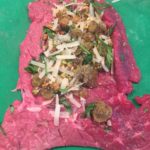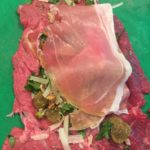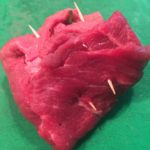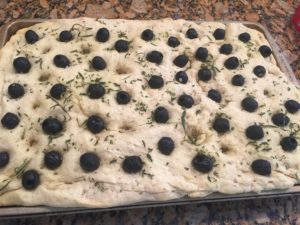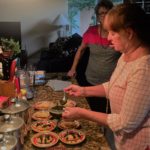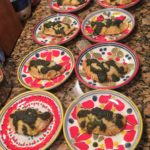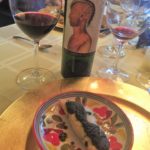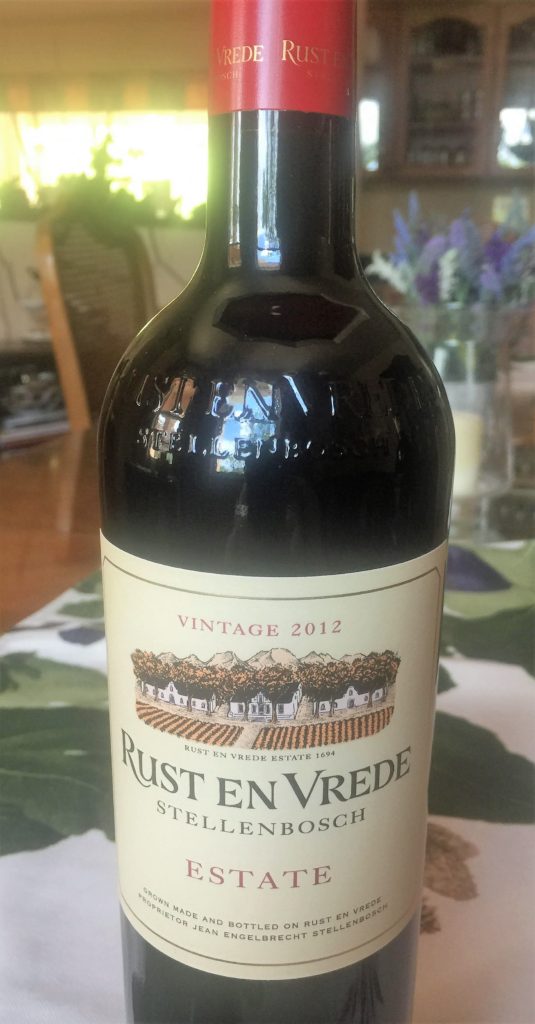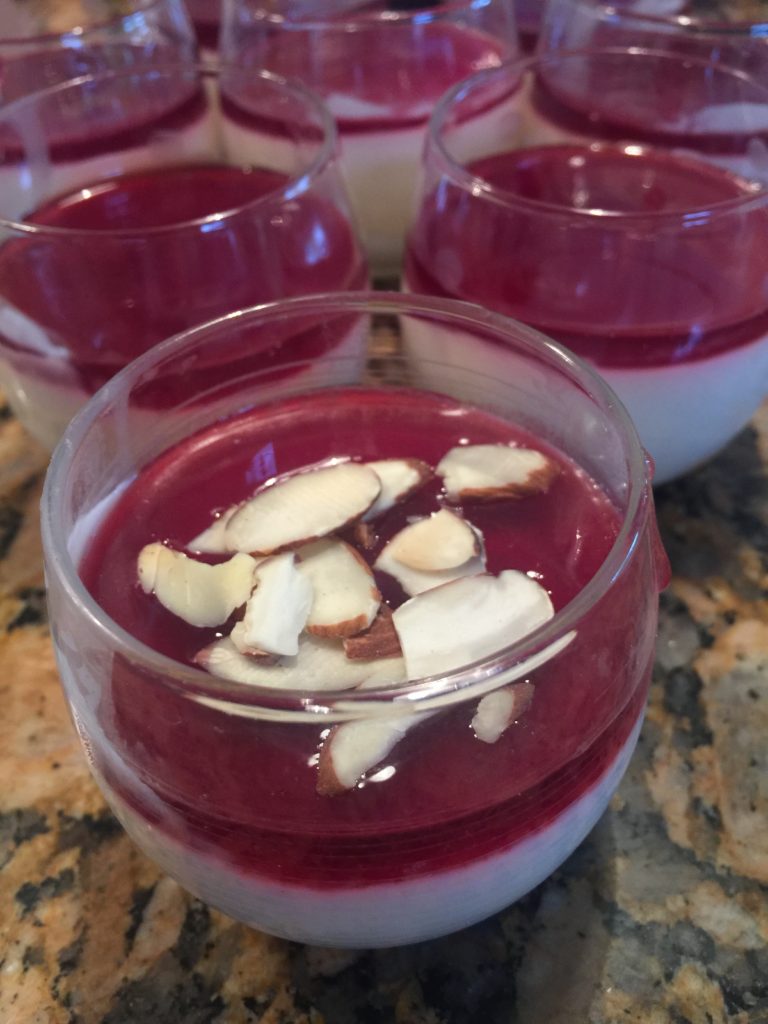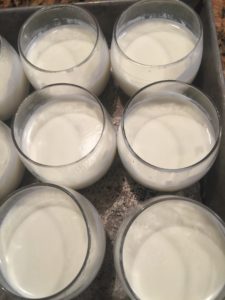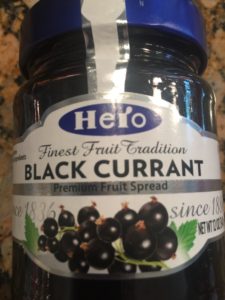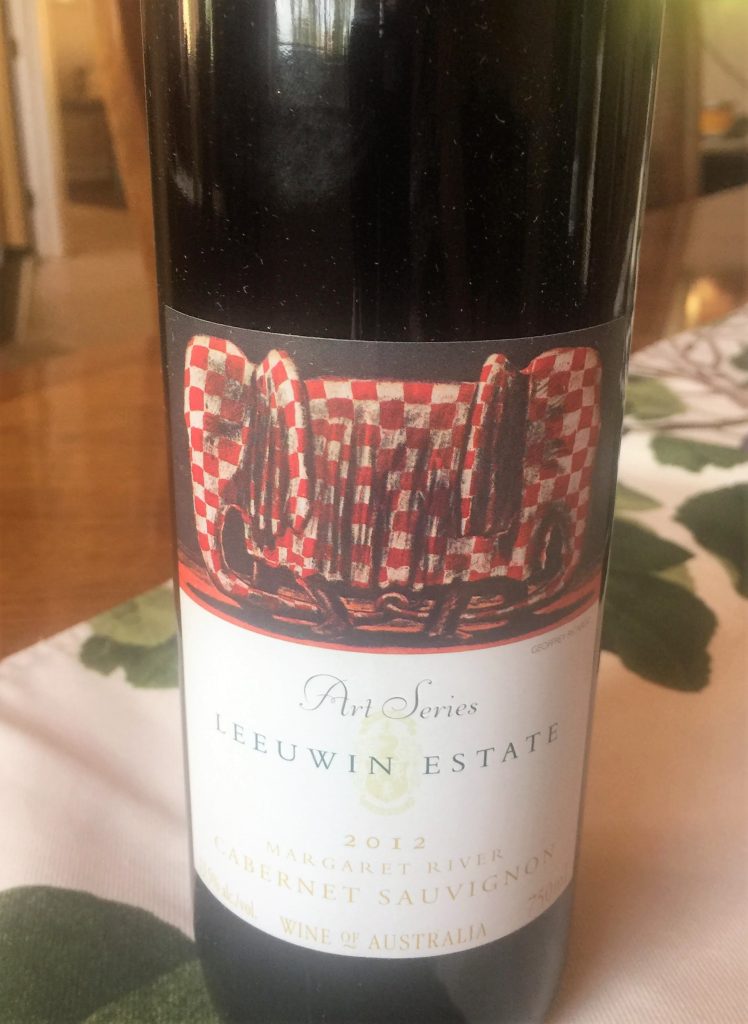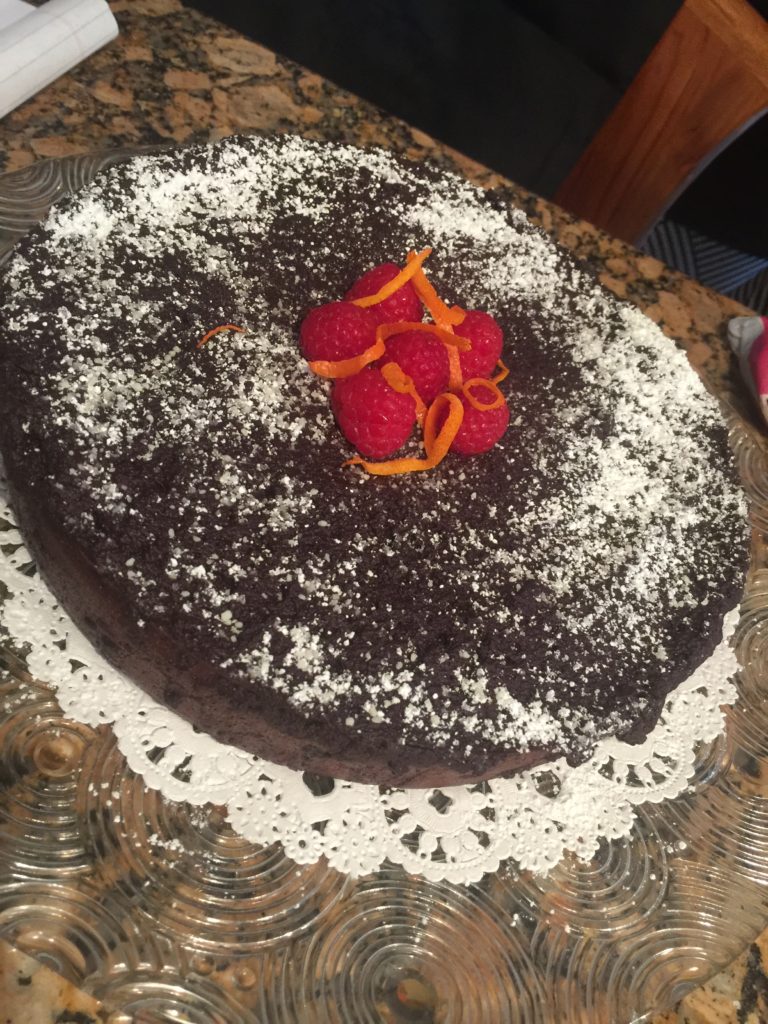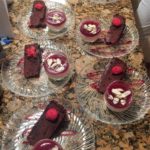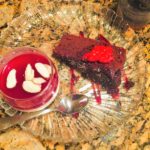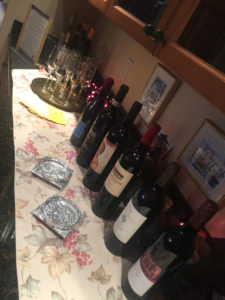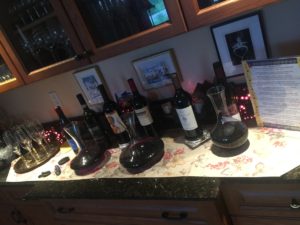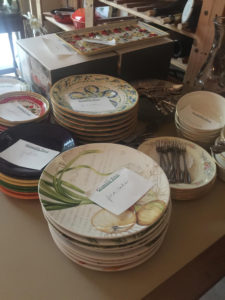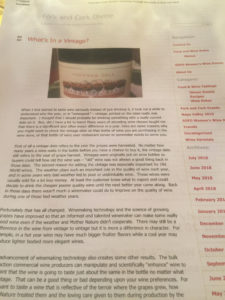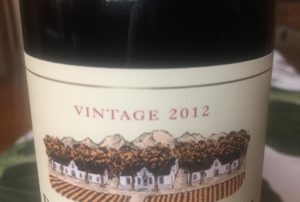
When I first started to taste wine seriously instead of just drinking it, it took me a while to understand why the year, or in “winespeak” – vintage, printed on the label really was important. I thought that I should probably be drinking something with a really current date on it. Boy, did I have a lot to learn! Many years of attending wine classes taught me that there is a significant and often major difference in a year. Here are some reasons why you might want to check the vintage date on that bottle of wine you are purchasing in the wine store, or that bottle of wine your restaurant server or sommelier wants to serve you.
First of all a vintage date refers to the year the grapes were harvested. No matter how many years a wine waits in the bottle before you have a chance to buy it, the vintage date still refers to the year of grape harvest. Vintages were originally put on wine bottles so buyers could tell how old the wine was – “old” wine was not always a good thing back in those days. The second reason for adding the vintage was especially important for Old World wines. The weather plays such an important role in the quality of wine each year, and in some years very bad weather led to poor or undrinkable wine. These wines were usually sold for a lot less money. At least the customer knew what to expect and could decide to drink the cheaper poorer quality wine until the next better year came along. Back in those days there wasn’t much a winemaker could do to improve on the quality of wine during one of those bad weather years.
Fortunately that has all changed. Winemaking technology and the science of growing grapes have improved so that an informed and talented winemaker can make some really good wine even if the weather and Mother Nature didn’t cooperate. There may still be a difference in the wine from vintage to vintage but it is more a difference in character. For example, in a hot year wine may have much bigger fruitier flavors while a cool year may produce lighter bodied more elegant wines.
The advancement of winemaking technology also creates some other results. The bulk production commercial wine producers can manipulate and scientifically “enhance” wine to the point that the wine is going to taste just about the same in the bottle no matter what the vintage. That can be a good thing or bad depending upon your wine preferences. For me, I want to taste a wine that is reflective of the terroir where the grapes grew, how Mother Nature treated them and the loving care given to them during production by the winemaker. If the weather creates some very bad vintage wines, some winemakers won’t even send them to market!
Sunshine is the main ingredient in a good or bad vintage. Just like many other crops, grapes have their best chance to fully mature and get that perfect level of ripeness with the “just right” amount of sunshine. If they don’t get enough, they might become diseased, rot or not fully ripen. Wines may be unbalanced without an enjoyable taste. If they get too much (too many days above 92 degrees), they might turn into little raisins! Wines made from these grapes may have bitter tannins.
There are some other important factors in predicting the quality of a vintage. The vintage can be affected in different parts of the world. The Northern Hemisphere growing season is from April to October and in the Southern Hemisphere, grapes are growing from October to April. Spring frosts and hail storms can create havoc in semi-continental climates like Burgundy and New York State. If the growing season is too short, the quality can be reduced. Fungal disease will ruin grapes in the summer with too much wet weather in wine growing regions like Germany and Virginia and some really really hot weather and drought can reduce quality of grapes in regions like Argentina or California. Then there is fall — rain or cold weather wreaks havoc on grape quality at harvest time.
Winegrowing regions with the most variable climates really live more precariously on the quality of their grapes and wine from vintage to vintage. France (Bordeaux, Burgundy, Champagne), Northern Italy (Piedmont, Lombardy, Veneto, etc), Northern Spain, Germany, New Zealand, Chile and Austria all have less predictable growing seasons. Lucky for California, Southern Italy, Argentina, Australia, Central Spain and Portugal who have more consistent grape-growing weather vintage to vintage. Yes, bad things still do happen – like totally abnormal drought……or hail storms of unbelievable magnitude… or fires! But for the most part Mother Nature is generally kind to this group of grape-growers.
We can’t forget that different grapes have different climate preferences. A bad vintage due to too cool weather may downgrade the red wines from a particular region, but the whites of that region may be excellent with crisper acidity and more vibrant flavors resulting from cooler temperatures.
Some wines don’t have any vintage dates. “NV” on a bottle of Champagne means that it has been made by blending multiple years together. It is usually consistent in the “house style” of that producer and is usually a good value.
So what are we wine lovers to do when it comes to judging the vintage on a bottle? If you are really interested now in the quality of wine to expect in a particular vintage, you can search the internet routinely for wine blogger articles, ask a wine salesperson or sommelier whose opinion you value or follow vintage reports published each growing season by wine publications like Wine Spectator, Wine Advocate or Wine Enthusiast. They all publish Vintage Charts that will give you some info on that bottle of 2010 wine you are about to pop open. By the way, 2010 was a great year for quality wine in most parts of the world. Chuck and I visited Napa Valley in 2010 and the winemakers all told us that anyone could make good wine that vintage! Well, I don’t know about that, but we got the point.
As mentioned earlier, vintage quality can be different from hemisphere to hemisphere and country to country – and even for specific regions in the same country.
A Case Study in Vintages: The Year 2012……………..
2012 Vintage Wines “A Tour of Two Hemispheres and Five Continents”
Several months ago Chuck and I had the privilege of attending a “2012 Vintage Italian Wines” themed wine dinner at Palladio Trattoria in Bonita Springs, Florida. The wines were sourced from Leonardo Locascio Selection/The Winebow Group and presented by Marcello Palazzi, Regional Manager. The food prepared by Chef/Owner Emanuela Calcara was delicious and perfectly paired with the wines. The wines were all excellent, and of course I purchased all of the wines served that night because I just knew that one day in the near future we would be having our own version of a 2012 vintage wine dinner. And that is how “2012 Vintage Wines” became my next wine adventure!
While drinking wonderful 2012 wines from across Italy is special enough, my researching instincts took over and I decided to look into 2012 vintages from several other wine-growing regions. I started with the premise that we would try wines strictly from the Northern Hemisphere. Wine insanity took over yet again and next thing I knew, my “case study” had grown to two hemispheres and five continents! But before I can share them with a few winelover friends, we need to have some understanding of how each hemisphere and continent can differ during the same vintage. Here is what I learned about vintages in each continent plus an example of a wine or two from those continents/regions.
Overall View of the 2012 Vintage: The Northern Hemisphere
The year 2012 was considered to be a very very good year for grapes in almost every wine region of the world, but it was especially good in the Northern Hemisphere. 2010 and 2011 were cooler vintage years and gave smaller yields, but in 2012 the weather was perfect up and down the west coast of the United States. We got just about everything desirable in a good wine. The quality was even higher than usual in lower price wines (under $12). The higher the price, one usually expects the more special it should be. And they were – in structure, complexity and purity. Moving across the ocean, 2012 was less memorable in Bordeaux; however it was still a good year. Quality was also high in Spain and Burgundy but so were the prices because less wine was made in 2012. German Riesling was extraordinarily pure with great focus and balance.
United States (Western Hemisphere)
In the United States, West Coast vintners reported their easiest season in years. The Pacific Northwest celebrated a warm growing season after a cold 2011. After two vintages with record breaking cool temperatures, Oregon was happy to have warm weather with a dry summer which produced Pinot Noirs with deep color and rich fruit. Washington State vintners said that 2012 was much like 2008, one of the best vintages ever. East Coast vintners were happy to have sunshine after lots of rain the previous year. Virginia vintners were just happy to be finished with the disastrous waterlogged 2011. And how about California? It was a long sunny year, and after two tough harvests they now had plenty of gorgeous grapes and outstanding wine. Just to show how the good news can vary even from region to region, up north in Anderson Valley, in Sonoma, and Napa Valley, the great growing season gave them just one problem: they weren’t prepared for such a big crop! Why should this be a problem you ask? Winemakers had to find space to process all those grapes! And Paso Robles? They got a heat wave which meant a small crop. A little further south in Santa Barbara, everything ripened close together and yields were high. Guess you just can’t have everything!
2012 Peay Vineyards Estate Pinot Noir “Elanus”, Sonoma Coast, California
Peay is a small family owned and operated winery began in 1996 on the northern Sonoma Coast. Almost all wines are made from grapes grown on their 51 acre hilltop vineyard above a river in the far northwestern corner of the West Sonoma Coast, 4 miles from the Pacific Ocean at Sea Ranch. Some wines are produced in less than 100 case quantities. The San Francisco Chronicle picked them as the “Winery of the Year” back in 2009. Vintages play a big part in their life. Production was off by 50% in 2010 due to a cold and wet fall and in 2011, wines were excellent but not plentiful as they lost 60% of their crop. When their quality is off, they just don’t release wine for sale. Then along came 2012………..
“The 2012 vintage was the third cool growing season in a row. Unlike 2011 and 2010, however, the fall was dry and grapes were able to mature without any concern of rot or mildew. A long, cool and dry growing season resulted in wines of profound depth and intensity with bright acidity and impeccable balance. In addition, we achieved average yields of 2 to 2.25 tons per acre (a record for us). The quality and quantity allowed us to really fine tune our cuvees and resulted in some of the best wines we have made.
The exceptional 2012 saw the inauguration of a 3 barrel cuvée we will only  make when we feel a vintage is exemplary and the overall quality of the wines is so high we must pull aside the three best barrels to offer only to our mailing list customers.” Andy Peay, Peay Vineyards Newsletter Issue 22.
make when we feel a vintage is exemplary and the overall quality of the wines is so high we must pull aside the three best barrels to offer only to our mailing list customers.” Andy Peay, Peay Vineyards Newsletter Issue 22.
2012 Peay Vineyards Estate Pinot Noir “Elanus”
This inaugural cuvée was made from one barrel each of clones Pommard, 777 and 667. Each of these are used in the three estate cuvées regularly made – Scallop Shelf, Ama and Pomarium. On the nose, expect to find smoked cherries and seared duck fat, dense and intense in aroma. In the mouth, there should be well-integrated fruit, floral and earth flavors. Orange rind quality with herbal and pepper accents are held together by the dried needle and forest floor quality found in all Peay Estate Pinots.
Europe – France (Eastern Hemisphere)
France has a number of distinct regions with many different climates and growing conditions thus producing different quality of wines in the same vintages in different regions. For example 1945, 1947 and 1949 from Pomerol may still be superb and demanding prices to match while 1947 was a particularly good year in the Medoc, Graves, Burgundy and Loire regions. The Rhone and Champagne consider 1985 to be one of the best old vintages with reasonable prices that you can currently find. However, 2009 and 2010 have been the best vintages all across France.
The weather was normal in Bordeaux in 2012 which means “not great” with cool wet conditions causing possible mildew. Harvest was late everywhere and a lot of Left Bank Cabernet Sauvignons were picked in the rain. Merlot wines may have fared a little better in 2012. However, there were good wines made everywhere in Bordeaux. The 2012s are less expensive than 2009 and 2010 and lower even than the 2011s. Here is an example where wines were priced at 2008 levels but were much better than 2008 wines making 2012 a very good value. Some wine writers have nicknamed 2012 Bordeaux as “the value vintage”.
Clos Cantenac, St-Emilion Grand Cru “Petit Cantenac”, Right Bank, Bordeaux, France 2012
The Petit Cantenac is a “second wine” from the St-Emilion Grand Cru Clos Cantenac, a small chateau on 6 hectares of vines west of St-Emilion and fairly close to the banks of the Dordogne River. It is owned by Martin Krajewski, who also owns Chateau de Sours in the Entre-Deux-Mers region, and his partner Marcus Le Grice from New Zealand. Their farming approach is 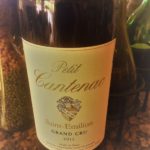 described as lute raisonnée (the reasoned struggle) which means that chemical intervention of any kind is reserved for only most urgent emergencies. According to the chateau tasting notes the grapes were picked in perfect conditions during the cool early mornings of late September and early October. However, the contrast between 2011 and 2012 could not have been more different. It started out with a cold winter followed by a relatively mild March but with difficult weather from late April until June. Bud break was at least ten days later than “normal” and they had to be on the alert for mildew. A late harvest was expected. All of a sudden they had a wonderful July followed by a blisteringly hot August and then on to heavy rains and winter-like weather. Amazingly it was considered by far the best summer in 10 years in Bordeaux. Under warm blue skies on Monday September 24th, Merlot grapes in perfect condition were picked. Then more rain! On Thursday weather improved enough to restart harvest. On Tuesday October 2nd the best quality Merlot was picked with the day ending in a spectacular sunset. The rest of the harvest was completed on the next day. “It had been a real roller coaster of a vintage and another year of living dangerously, but finally it was all over and gratefully we were very satisfied with the early results”.
described as lute raisonnée (the reasoned struggle) which means that chemical intervention of any kind is reserved for only most urgent emergencies. According to the chateau tasting notes the grapes were picked in perfect conditions during the cool early mornings of late September and early October. However, the contrast between 2011 and 2012 could not have been more different. It started out with a cold winter followed by a relatively mild March but with difficult weather from late April until June. Bud break was at least ten days later than “normal” and they had to be on the alert for mildew. A late harvest was expected. All of a sudden they had a wonderful July followed by a blisteringly hot August and then on to heavy rains and winter-like weather. Amazingly it was considered by far the best summer in 10 years in Bordeaux. Under warm blue skies on Monday September 24th, Merlot grapes in perfect condition were picked. Then more rain! On Thursday weather improved enough to restart harvest. On Tuesday October 2nd the best quality Merlot was picked with the day ending in a spectacular sunset. The rest of the harvest was completed on the next day. “It had been a real roller coaster of a vintage and another year of living dangerously, but finally it was all over and gratefully we were very satisfied with the early results”.
This particular 2012 wine was made from 85% Merlot, 9% Cabernet France and 6% Cabernet Sauvignon harvested 100% by hand on September 24 and October 3, then aged in 40% new French oak and 60% 2nd year barrels for 20 months. 16,000 bottles were produced. What results was wine with deep dark red color with fresh, lush rich notes of black plums, cassis, cherry, raspberry, figs and fine leather with further hints of licorice, spice and soft vanillary new oak. The soft tannins and aromatics spread across the palate and become more defined with an elegant rounded blackberry plum finish. (Tasting notes and harvesting comments from the Clos Cantenac website.)
Europe – Italy (Eastern Hemisphere)
There are three major Italian regions where vintages are especially important – Piedmont, Veneto and Tuscany. All three saw one of the best growing seasons in 1971 and bottles from 1971 sell for hundreds and sometimes thousands of dollars, especially Barolo. 1985 was also a great vintage for them; newer vintages to look for include 1997, 2010 and 2013.
How about 2012? Winemakers across Italy reported a promising vintage after a year of hard work. A wet spring lowered yields significantly in many regions. A long hot summer put the vines under stress from drought. Vintners had to protect the fruit while letting it hang long enough to ripen. The bad news is that yields were down in the Northeast, Piedmont, Southern & Central Italy and Tuscany. The good news is that healthy fruit was harvested in the Northeast, Nebbiolo was outstanding in the Langhe, Southern & Central regions harvested very ripe grapes, and Tuscany had good to outstanding quality in Montalcino, Chianti Classico and Montepulciano.
Lombardy, Northern Italy
2012 Barone Pizzini Franciacorta Brut Rose, Lombardia, Italy
Franciacorta refers to both its place of origin – Franciacorta was Italy’s first sparkling DOCG – and the method of production, the classic metodo where the second fermentation occurs in the bottle. You can find it in the Lombardia region of Italy, home to risotto, osso bucco and panettone. It borders on Switzerland and at one time was under French rule. Barone Pizzini was founded in 1870 by the noble family of Pizzini and is one of the oldest wineries in Franciacorta. It was the first one to promote biodiversity and natural farming methods, has 118 acres under vine and produces about 290,000 bottles a year. Silvano Brescianini is the winemaker, general manager and founding partner.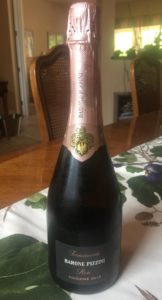
Rose Franciacorta is 100% Pinot Nero and is sourced from six vineyards all close to the edge of forests which maintain cool temperatures throughout hotter days of the growing season. The Pinot Nero is harvested in August, pressed and fermented in temperature controlled steel tanks, then aged six months in stainless steel and barriques before aging in bottles for 30-40 months on natural yeast and a dosage of 2-3 g/l of organic sugar. 2011 was the first vintage of this wine, and 20,000 bottles are produced annually.
2012 produced 40% less grapes in Franciacorta than 2011 and about 30% below the 10 year average, but the grapes were very good with high sugar content due to an extraordinarily dry summer with plenty of sun. The 2012 Barone Pizzini Brut Rose scored 89 points from Wine Enthusiast and the following tasting note: red berry, tangerine, a hint of pastry dough and a dash of cake spice. Crisp acidity lifts the creamy texture.
Veneto, Northern Italy
2012 Maculan Torcolato Breganze, Veneto, Italy
Maculan is a three-generation family winery founded in 1947 in Breganze, a village at the foot of the Asiago high plains in the Veneto region of Northeastern Italy. They have 40 hectares of their own devoted to vines and olive trees and also manage vineyards for 30 selected growers. They make wine from Cabernet Sauvignon, Merlot and Chardonnay but the Torcolato is a dolce wine made from the Vespaiolo grape, grown mainly in Veneto. Vespaiolo is best suited to sweet wine production. The Breganze Torcolato DOC is the style most often associated with Breganze and is the most respected. Only the best bunches, undamaged, ripe and open are used, gathered and placed in a single layer, so that they can be carried without damage. Then they are chosen again, twisted by winding around a couple of strings and hung from the beams of attics. This operation of twisting is called “torcolare” in the local dialect, and from this comes the name of the wine. The grapes must be hung in an attic or special room with adequate ventilation while they rest. Botrytis sets in during this time making the noble rot which fosters concentration of sugars and helps create special scents and aromas later found in the wine. Windows must be opened on sunny days and closed in bad weather. The grapes are then pressed producing a very low yield of about 25-30 liters of liquid from 100 kg of grapes. This liquid is then decanted and left to ferment in a thermally conditioned room to mature for one to two years in French oak barriques. The result is usually intense aromas of honey, dried fruit such as raisins, figs or apricots, notes of vanilla and scents of wood. It can age for 20 years or longer. 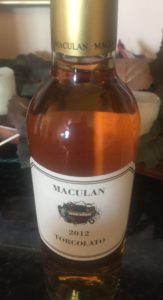
The Veneto also had a very hot and dry summer in 2012. In general the vintage was good but not amazing. Quality of grapes were high but yields were low. But Maculan made their 4800 bottles of Torcolato and Wine Spectator rated it 92 points. Their review: “A lovely, fragrant dessert wine, with honeysuckle and spice notes playing off rich accents of glazed apricot and salted caramel. Bright and mouthwatering, delivering a long, rich and creamy finish. Drink through 2025.”
Marche, Central Italy
2012 Pievalta Verdicchio dei Castelli di Jesi Classico Riserva, Sao Paolo Vineyard, Marche, Italy
Le Marché was invaded countless times and eventually became a border between the Holy Roman Empire and the Republic of Venice. During this time it became known as Le Marché, the word marka signifying a border area between two political entities. Many cultures have left their mark – short, squat Roman buildings, duomi of Renaissance cathedrals and castles. It is from these castles around the city of Jesi that the name Verdicchio dei Castelli di Jesi is taken. Verdicchio is the white grape varietal to know in Marche, and Castelli di Jesi Verdicchio Riserva DOCG is one of two Verdicchio DOCGs in Marche. Pievalta was made possible by Silvano Brescianini, the winemaker and managing partner of Barone Pizzini who founded this estate in 2003. There are 68 acres under vine and 120,000 bottles are produced annually. The Sao Paolo Vineyard was planted in 1992, and the first vintage was produced in 2003. In 2008 all Pievalta wines became Biodynamic – Demeter certified.
2012 was a very hot year in Marche as was the year before, but the wines 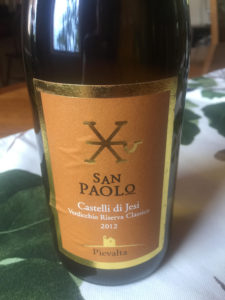 differed greatly in both vintages. Daytime temperatures in 2012 were high through most of the growing season which meant that grapes reached optimal ripeness. When heat comes suddenly late in the season as it did in 2011, grapes shrivel on the vine and turn into raisins.
differed greatly in both vintages. Daytime temperatures in 2012 were high through most of the growing season which meant that grapes reached optimal ripeness. When heat comes suddenly late in the season as it did in 2011, grapes shrivel on the vine and turn into raisins.
These Verdicchio grapes produce a light and fresh wine with a tell-tale varietal note of all Verdicchio often described as sweet almond. Expect some citrus, especially lime. This wine should be crisp, refreshing and age-worthy. It was fermented and aged in stainless steel tanks. Wine Enthusiast magazine rated it 89 points and gave the following tasting notes: “Spanish brown and beeswax scents float out of the glass. The round, juicy palate doles out mature yellow apple, tangerine zest and a hint of honey while a note of marzipan backs up the finish. Bright acidity lifts the creamy flavors”.
Campania, Southern Italy
2012 Mastroberardino Radici Taurasi, Aglianico, Campania, Italy
2012 was an exceptionally hot, dry vintage across this region with higher than normal temperatures, but late rains and cooler conditions brought relief when harvest began. However, Aglianico is a late-ripening variety that struggled to balance sugar and phenolic maturation. It seems to have won the battle for Mastroberardino Radici Taurasi. It was deemed 93 points from Wine Enthusiast, Wine Spectator and James Suckling with 91 points from Robert Parker. Only 2007 and 2006 received higher ratings in the past 8 years.
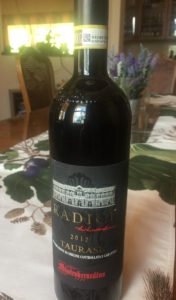 Mastroberardino is one of the leading wineries and wine families in all of Italy in terms of production, market impact, and innovation with a winemaking history which dates back to the early 18th century. They have become a guardian and protector of indigenous grapes of Southern Italy’s Campania region. The family has not just worked to maintain these varieties, but Mastroberardino has successfully turned would-be extinct grapes into world class varieties. The winery was selected by the Italian government in 1996 to manage the preservation of Pompeii’s ancient viticultural techniques at the Villa dei Misteri archaeological site. They planted vines inside the ruins following plans and methods used by the Ancient Romans prior to the eruption of Vesuvius in 79 BC. Today Mastroberardino produces around 150,000 cases of wine from 150 acres in Campania and other areas. Taurasi is one of their flagship wines. The acclaim from their 1968 Taurasi Radici Riserva brought widespread attention to the area and the Aglianico grape.
Mastroberardino is one of the leading wineries and wine families in all of Italy in terms of production, market impact, and innovation with a winemaking history which dates back to the early 18th century. They have become a guardian and protector of indigenous grapes of Southern Italy’s Campania region. The family has not just worked to maintain these varieties, but Mastroberardino has successfully turned would-be extinct grapes into world class varieties. The winery was selected by the Italian government in 1996 to manage the preservation of Pompeii’s ancient viticultural techniques at the Villa dei Misteri archaeological site. They planted vines inside the ruins following plans and methods used by the Ancient Romans prior to the eruption of Vesuvius in 79 BC. Today Mastroberardino produces around 150,000 cases of wine from 150 acres in Campania and other areas. Taurasi is one of their flagship wines. The acclaim from their 1968 Taurasi Radici Riserva brought widespread attention to the area and the Aglianico grape.
Winemaker notes from the 2012 vintage for this 100% Aglianico include full complex aromas particularly of violet and blackberries with full-bodied persistent elegant notes of plum, bitter cherry, strawberry jam and black pepper. Other critics mention underbrush, menthol, licorice and tobacco; spice box, graphite, savory wild herbs, black walnut, black olive, Morello cherries and round chewy tannins.
Overall View of the 2012 Vintage: the Southern Hemisphere
While the grapevines are flowering in the US and Europe, wines are quietly aging in their barrels down south in countries like Chile, South Africa and Australia. The 2011-2012 growing season was challenging in Argentina. It was also very warm and dry in Chile. The growing season in South Africa had cool and dry weather conditions that led to reduced crops and small berries but vintners were happy with the overall results. Inland wine growing areas recorded some of the best crops ever, but the coastal region had dwindling water supplies and a decrease in crops. Yields were also lower in much of Australia. But this was the only sour note for Australian vintners. Most Aussie winemakers made less wine but of better quality. In fact some Southern Australian winemakers and critics called 2012 “the vintage of the century” using descriptors like “outstanding”, “sensational” and “perfect in every way”.
Chile (Western Hemisphere)
Mendoza, Argentina growers got delayed ripening while across the Andes, Chile had a very warm dry year that caused red grapes to ripen too quickly. Some winemakers reported the warmest temperatures on record, but most of them were prepared for the harvest that began two to four weeks earlier than normal. Despite the atypical heat, most of them also avoided mold and insects and had a healthy crop. The reds were smaller and sweeter than normal with high potential alcohol and minimum phenolic ripeness testing a winemaker’s skills. The cooler Chilean microclimates had lower temperatures especially at night making complex and elegant wines this year from the cool coastal San Antonio appellation.
2012 Clos Quebrada De Macul “Domus Aurea” Cabernet Sauvignon, Maipo Valley, Chile
Clos Quebrada de Macul is a single hillside family owned vineyard located in the Maipo Valley high up on the slopes in the foothills of the Andes. The 45 acre vineyard was planted with Cabernet-blend vines in 1970. It was unheard 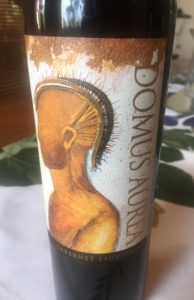 of in Chile at this time to plant on hard-to-farm lower-yielding hillsides. The blend of vines planted is 80% Cabernet Sauvignon, and a 20% blend of Merlot, Petit Verdot and Cabernet Franc. Prior to their debut of Domus Aurea in 1996, the owners Isabelle and Ricardo Peña sold their grapes to top wineries across Chile, and it soon became the most expensive fruit in the market. This motivated them to bring in a winemaker and make their own. Domus Aurea has become one of the leading examples of site-specific, low-yield non-interventionist winemaking. Since then, wine critics around the world rate it between 90 and 96 points every vintage.
of in Chile at this time to plant on hard-to-farm lower-yielding hillsides. The blend of vines planted is 80% Cabernet Sauvignon, and a 20% blend of Merlot, Petit Verdot and Cabernet Franc. Prior to their debut of Domus Aurea in 1996, the owners Isabelle and Ricardo Peña sold their grapes to top wineries across Chile, and it soon became the most expensive fruit in the market. This motivated them to bring in a winemaker and make their own. Domus Aurea has become one of the leading examples of site-specific, low-yield non-interventionist winemaking. Since then, wine critics around the world rate it between 90 and 96 points every vintage.
The season was characterized by a hot dry summer, registering high temperatures especially in March, which bumps up the harvest to maintain good acidity and freshness. Harvest started quite late – early April for Merlot, end of April for Cabernet Sauvignon and Franc and finished with Petit Verdot on May 10th. The 2012 aged 12 months in 20% new French barrels with varying degrees of medium toast. The final blend was 85% Cabernet Sauvignon, 6% Cab Franc, 4% Petit Verdot and 5% Merlot. 19,369 bottles were produced.
Although 2012 had a reputation for being too warm with wine made from very ripe grapes, the critics gave it high scores: 94 points from Robert Parker and 92 points from Wine Enthusiast. In previous years, Parker rated it as high as 96 points. Here’s his review: “the 2012…showed very good freshness. It’s a year of tremendous concentration but overall keeping the character of the place, which to me is the signature of this wine. It’s always intensely balsamic, powerful and elegant, with notes of wild herbs and flowers”. The winemaker notes include dense deep dark purple with impressive nose, heavy notes of creamy cherries and black currant, lots of oriental spices, cigar box, dried fruits, stony notes, menthol and balsamic tones with leather hints; on the palate jammy fruits, spicy oak and minty tones with great tannic structure and a balance that will be fully expressed in time (drink 2016 – 2029).
South Africa (Eastern Hemisphere)
The 2011-2012 growing season was slow and smooth in South African wine regions. Yields were reduced due to the dry winter, but grapes ripened gradually during a cool summer producing a promising quality. This was the third straight year for noticeably dry conditions, but the lower-than-usual rain levels combined with a cool start to spring in 2012 led to reduced crops and small berries; however vintners were happy with the overall results. Disease pressure was very low and the resulting crop was very clean. Alcohols were not very high but with superb phenolic ripeness. One Stellenbosch vintner, David Trafford, reported “the harvest period was about as ideal as I’ve ever experienced”. David Finlayson, vintner, reported that “If we ever had a vintage that was close to a dry Bordeaux vintage, this is it. The reds are intensely concentrated and the whites are smooth and creamy”.
Stellenbosch, Southwestern South Africa
Wine has been produced in South Africa for longer than in any other of the new world countries. It has been the 8th biggest wine producer in the world for several years. South African vineyards cover 140,000 hectares but the most important area known for making fine wine is the Western Cape geographical unit, located in the most southwesterly part of the country. The Coastal Region is the most important of the Western Cape and it contains 8 districts which include the fine wine districts of Stellenbosch, Paarl, Constantia and Franschhoek Valley. Stellenbosch is just a short distance east of Cape Town and is considered the country’s leading wine area. It is home to many of the country’s leading estates. It is known for producing Cabernet Sauvignon, Merlot, Pinotage, Syrah, Chardonnay, Chenin Blanc and Sauvignon Blanc.
2012 Tokara Director’s Reserve White Bordeaux Blend, Stellenbosch
Business tycoon GT Ferreira bought the Tokara Farm in 1994 with a plan to design a wine production and marketing facility to reflect the character of innovative and distinctive wines. The buildings are industrial in nature made from natural materials with clean strong lines offering clarity of form with a breathtaking environment. The winery itself uses cutting edge technologies and computerized control systems to ensure the wines meet their standards of excellence. Tokara is indeed the modern face of Stellenbosch winemaking. The wines are intense, complex, balanced, distinctive and sophisticated with a strong sense of place. In addition to the wines there is also a terrific restaurant and a ubiquitous display of art. Miles Mossop has been part of the team for the past 17 years and has a reputation as one of South Africa’s leading winemakers. “The object of the exercise is to see how high we can raise the cross bar” – GT Ferreira, Owner.
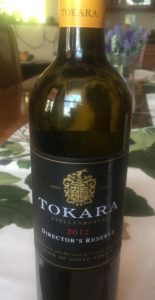
The Director’s Reserve White is a Bordeaux blend of 74% Sauvignon Blanc and 26% Semillon. The grapes were hand harvested at optimal flavor ripeness then barrel fermented in 30% new French oak. The wine spent a total of 10 months in the barrel and 15000 bottles were produced. It has a vibrant pale straw color, complex nose intense with aromas of greengage, quince, passion fruit and toasted almonds. The oaking is perfectly balanced with intense fruit flavors and notes of buttered toast. It is mouth filling with a long crisp finish. And it has a screwcap! Robert Parker gave it 91 points.
2012 Rust en Vrede Stellenbosch Estate Red Bordeaux Blend
The Rust en Vrede Estate has existed for over 320 years but the Engelbrecht family has only been making wine there since 1977. Production of Estate wines varies between 30,000 to 60,000 bottles per year from 55 hectares and 50% of it is exported to more than 30 countries around the world. Their 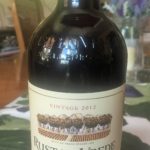 underground cellar was the first of its kind for a privately owned South African winery. They specialize in producing only red wine with the focus on Syrah, Cabernet Sauvignon and Merlot. In 1993 President Nelson Mandela chose Rust en Vrede wine to be served at the Nobel Peace Prize dinner in Oslo. In 1998 Rust en Vrede became the first South African wine to be named in Wine Spectator’s Top 100, and it made the list a number of times after that including the fifth time in 2012. Their wine is frequently awarded 90plus ratings by Wine Spectator. In 2016, Jean Engelbrecht was named an international leader of wine by Wine Spectator.
underground cellar was the first of its kind for a privately owned South African winery. They specialize in producing only red wine with the focus on Syrah, Cabernet Sauvignon and Merlot. In 1993 President Nelson Mandela chose Rust en Vrede wine to be served at the Nobel Peace Prize dinner in Oslo. In 1998 Rust en Vrede became the first South African wine to be named in Wine Spectator’s Top 100, and it made the list a number of times after that including the fifth time in 2012. Their wine is frequently awarded 90plus ratings by Wine Spectator. In 2016, Jean Engelbrecht was named an international leader of wine by Wine Spectator.
2012 may have produced a slightly lower crop size; it was the fourth driest year over the previous 44 years, but quality wines were produced. The 2012 Estate Red Blend of 56% Cabernet Sauvignon, 36% Shiraz and 8% Merlot received 93 points from Wine Enthusiast, 92 Wine Spectator and 91 Robert Parker. The lowest rating since 1998 was 91 points. Obviously Rust en Vrede knows how to make good wine consistently! Winemaker notes: deep crimson red color with Shiraz very prominent on the nose with notes of cedar and cumin, backed up by cigar box and tobacco aromas; classic blackberry, plum and mulberry flavors; full bodied with great structure and length and an old world style with long, dry finish. Other critic’s comments include cassis, black cherry, black currant, raspberry sauce, cocoa, charred spice, hint of charcoal, touches of leather and perfumed violet aromas. These wines are aged 18 months in 100% French oak with medium toast and an aging potential of 10 to 15 years.
Australia (Eastern Hemisphere)
The Australian wine industry suffered through years of heatwaves, bush fires and heavy rain, but 2012 brought some of the best growing conditions in decades. Consistent weather with fewer periods of extreme heat made a difference in most regions. Top Australian wine writers said that the weather was “nigh on perfect” in South Australia, Victoria and Western Australia. The grapes had a high amount of natural flavor and good wines should have great balance and harmony not dominated by elevated alcohol or almost over ripeness. The only issue was reduced yields in some regions. The wine industry body Wine Australia said that the lower priced categories were losing favor with some commentators around the world, and winemakers were realizing that they need to be trading in higher price points for the long term. The cheaper priced wines (i.e. Yellow Tail) continue to sell in big numbers but should increasingly become the exception.
Margaret River, Western Australia
It was all good news for the 2012 vintage in Western Australia. They had good rains, then a very warm dry summer. In fact January was the hottest in 11 years but did not damage the grapes. Cabernet Sauvignon and Chardonnay were described as exceptional. However, this is nothing unusual for the Margaret River wine region in Western Australia. Over 100 years ago, some Italian immigrants travelled to the southwest corner of Western Australia and planted cuttings of a little-known grape variety called “Fragola”. These vines produced the first wines, nicknamed “red dynamite”, sold in Margaret River. Times have changed and Margaret River has recently celebrated its 50th anniversary as a wine region. In the mid-1960s agronomist Dr. John Gladstones identified Margaret River as having vast viticulture potential. The first commercial vines were Cabernet Sauvignon, Shiraz, Malbec and Riesling. Vasse Felix, Moss Wood, Woodlands, Cape Mentelle and Leeuwin Estate were some of the founding wineries who worked diligently to make this region’s reputation as a premium wine producer. A certain Californian winemaker also thought the region had enormous potential – Robert Mondavi traveled to Margaret River to a patch of land owned by Denis and Tricia Horgan. Not wanting to sell their cattle farm property now known as Leeuwin Estate, the Horgans gained Mondavi and his son Tim as mentors. According to Denis Horgan, Mondavi always said that Margaret River was going to make wines that ranked with the best in the world. And then there is Dr. Gladstones who says that “with its environments, experience and now increasing vine age, Margaret River is undoubtedly ripe to walk with the greatest”.
Over the last 50 years Margaret River has built an international reputation for producing powerful, yet elegant Cabernet Sauvignon, Chardonnay and Semillon/Sauvignon Blanc blends. Margaret River has now become so highly thought of in the wine world, that it was a contender for Wine Enthusiast Magazine’s wine region of the year in 2017. Unfortunately it had some really stiff competition and lost out to Southwest France, which you may have read about in many wine magazines, websites and even my own forkandcorkdivine.com celebration of wines of the Sud Ouest, Southwest France wine region.
2012 Leeuwin Estate Art Series Cabernet Sauvignon
Leeuwin Estate is one of the five founding wineries in the Margaret River district of Western Australia. Two generations of the Horgan family work with highly skilled winemakers to consistently produce wines ranking among the world’s finest. Under the mentorship of Robert Mondavi, the cattle farm transformed into Leeuwin Estates Winery produced their first commercial vintage in 1979. Leeuwin made the international spotlight when Decanter Magazine gave its highest recommendation to the 1980 “Art Series” Chardonnay. Accolades keep on coming and Leeuwin exports to over 30 markets. The Estate now has fine wine, food, art and music with an award winning restaurant, cellardoor and art gallery. Wines are released under the Art Series, Prelude Vineyards and Siblings labels. The “Art Series” represent the most opulent and age-worthy wines. Each wine is identified by a label picturing a painting commissioned from leading contemporary Australian artists. Prelude Vineyards wines are made to enjoy young while the Siblings celebrates family lineage. The Art Series Chardonnay and Art Series Cabernet Sauvignon are included in Langton’s wine auction house Top 40. Wine Spectator has included Art Series Chardonnay in the top 100 list with the 2011 vintage ranked wine #5 in 2014. Art Series Cabernet Sauvignon has been included in Decanter Magazines Top 50 wines of the year.
The 2012 Art Series Cabernet Sauvignon has 90 plus point ratings almost too numerous to mention – as do all the previous vintages! Ratings – 97 points 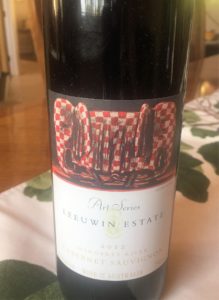 JS, 96 Australian Wine, 95 Wine.com, 92 WE, 91 RP and 90 WS. The 2012 is 100% Cabernet Sauvignon with artwork entitled “Forwards Backwards” by Geoffrey Ricardo. Tasting notes from the winemaker: “dark ruby red with a black core, vibrant and concentrated fruit aroma of blackcurrant, dark cherries and mulberry. Beneath the lifted aromatics of anise, cocoa, clove, black olive and earthy wild field mushroom provide elegant layers to expressive and complex nose……..dark fruit core of blackcurrant and forest fruits. Savory spices of dried sage, cassia bark and tobacco give subtle texture………finish featuring slightly chalky cocoa powder-like tannins.” James Suckling called it the Mouton-Rothschild of Australia.
JS, 96 Australian Wine, 95 Wine.com, 92 WE, 91 RP and 90 WS. The 2012 is 100% Cabernet Sauvignon with artwork entitled “Forwards Backwards” by Geoffrey Ricardo. Tasting notes from the winemaker: “dark ruby red with a black core, vibrant and concentrated fruit aroma of blackcurrant, dark cherries and mulberry. Beneath the lifted aromatics of anise, cocoa, clove, black olive and earthy wild field mushroom provide elegant layers to expressive and complex nose……..dark fruit core of blackcurrant and forest fruits. Savory spices of dried sage, cassia bark and tobacco give subtle texture………finish featuring slightly chalky cocoa powder-like tannins.” James Suckling called it the Mouton-Rothschild of Australia.
The Last Five Years
The harvest reports that were published during and after the 2012 vintage seemed to agree that the grapes would make good wine north, south, east and west in the wine producing countries of the world. However, the final proof comes in the bottle. I plan on tasting the wines presented in the case study in the very near future and can let you know if my tasting companions agree with the winemaker predictions and the critic scores. Or better yet, you can get some of your own vintage bottles – either 2012 or any other vintage you prefer – and compare your findings to those of the winemakers and critics.
What’s been happening since 2012? Here are some harvest reports from the last 5 years:
In 2013, California was still under severe drought but reported a record harvest. Europe described a very wet year which can lead to a very tricky harvest. In the southern hemisphere, South Africa found the year one of the most rewarding but also one of the most challenging. Australia reported a small crop.
2014 was another record-breaking drought year in California while the East Coast suffered from a deep freeze, and the Northwest got a crop so big they had to scramble looking for enough vats to hold the grapes. It was another challenging wet year for European winemakers and down under in Margaret River, a very high quality vintage was expected. Chile had a severe spring frost which created one of the smallest crops in years but good wines. South Africa reported a wet and wild year.
Here’s the title of an article posted about 2015 in Paso Robles – “Post Mortem on a Disastrous 2015 Grape Harvest” ……….’the worst harvest in memory’ in 2015…….yields in many Central Coast vineyards dropped 50% below average due to a combination of extreme weather and accumulated drought conditions. The only good thing about 2015 is that it’s over”. Meanwhile Napa and Sonoma started harvest in August which ended up with a lot less fruit than 2012, 2013 or 2014. Lower yields, but high quality! So once again it depends upon what part of wine country you are in. South Africa found the 2015 harvest to be one of the driest and earliest in years – two weeks earlier than usual. Margaret River reported lower yields as much as 20 to 30%. Our friends in Italy reported an amazing harvest of better than average quality with an overall volume of wine that exceeded all other countries.
Some headlines reported about 2016:
Wine Harvest Report 2016: Sonoma Winemakers Wrap the Season on a High Note………Vintners say early rains lowered some yields, but a warm, steady summer produced promising wines.
Wine Harvest Report 2016: A Record-Breaking Haul Has Washington Vintners in Good Spirits……….After a warm spring and early summer, steady weather prevailed, producing promising quality.
Wine Harvest Report 2016: Burgundy’s Frost and Hail Produced High Quality and Low Quantities…….Vintners from Chablis to the Mâconnais report a year of extremes that devastated some vineyards but produced gorgeous wines in others.
Wine Harvest Report 2016: Provence
After a season of severe drought and hungry boar, Bandol producers note lower yields and high quality.
2017 was quite unique in California. It was the year that ended a 5 year drought followed by horrendous wildfires that wiped out wine communities and took with them several wineries and vineyards. The official word was that the harvest was “in” when the fires came through and grapes not affected, but the proof will be in the bottle…….or in future vintages from the grapevines that lived through the smoke. Across the Atlantic France reported picking their smallest crop since 1945 due to a year of chaotic weather which included frost, hailstorms and a heatwave known as “Lucifer”! Italy had one of their smallest harvests in 60 years. South Africa had yet another extremely dry growing season. Argentina and Chile had a frost delivered by La Niña and extremely dry conditions after a number of very wet years resulting in forest fires that caused damage to some vineyards.
Think you want to be a vintner or winemaker? The one thing they have in common all around the northern and southern hemisphere and every continent is that the outcome of their work all depends upon the weather. Is it too rainy or is there a drought? Enough sun or is the heat unbearable? The weather patterns are chaotic and make the work of a vintner much more unpredictable. But somehow he or she must know the right thing to do! Their entire year’s work depends upon it.
Is Vintage Really that Important?
We just talked about why we have vintage dates on our favorite bottles of wine and have done an in-depth study of the year 2012 vintage in two hemispheres and across five continents. Now here is the all-important question that I’m sure you have been wanting to ask – is the vintage really that important? Some people buy a bottle of wine because they know and like the grape in it. Some really like a particular region. Some like a particular grape variety so much that they are not going to drink any others. To some, or most of us, price is a factor. And then there are wine drinkers who just happen to like the shape of the bottle or the label. But not too often do I hear normal wine drinkers talking about the vintage when selecting the wine. If you are a wine “geek”, you probably do consider the vintage even if briefly. However there are some winemakers and critics brave enough to promote the theory that “There really is no such thing as a bad vintage of wine, only bad winemakers.” As we said early in this article, there are geographical areas where vintages matter very little due to the predictability of their climates. Vintages may be nothing more than guidelines which may or may not tell you of the quality of wine in the bottle. Even in years proclaimed as “poor” vintages, you always read about wines that are quite good deals and to be sure to buy them. Then there are the large-scale producers who manipulate the wines to ensure that they are consistent every vintage. So if you are a wine drinker similar to me (a wannabe “wine geek”), vintage really does matter because I definitely do not want to drink mass produced wines that always taste the same. You may have heard the statement that wine is a living thing and each bottle has a story to tell. I, for one, want to know that story. In fact I really enjoy doing vertical tastings of the same wine from the same winery just to see how it changes from year to year.
A University of Chicago professor did an experiment a few years ago to see if experienced wine tasters could actually tell the difference between wines from high quality makers that had been labeled by wine experts, i.e. Robert Parker, to be from a “good” vintage instead of a “bad” one. The results were not too surprising. The differences were indistinguishable except for wines from one region, Bordeaux. Figure that one out! A vintage DOES matter to collectors who hope to make a large profit on wines of “good” or “exceptional” vintages, but at the price point of around $20, we are not putting that bottle away to save for a big profit. We are drinking it now. Might it taste a little different in a few years? It might but not significantly enough to get hung up on the vintage. Gone are the years of total harvest bust; however, very reputable winemakers may not even offer for sale wines from a year they thought was a bust. At the very least, they will make second or third label wines with those grapes, or ship them off to the bulk producers.
You can find exceptional wine in even the weakest vintages. Most wine lovers – ranging from normal to wine geeks – depend more upon the winemaker and the producer than the vintage. Maybe those NV (non- vintage) wine makers have the right idea after all. So here’s hoping that the wine you are enjoying right now is the perfect vintage for you!
7.3.18 LR
LFRakos@gmail.com
